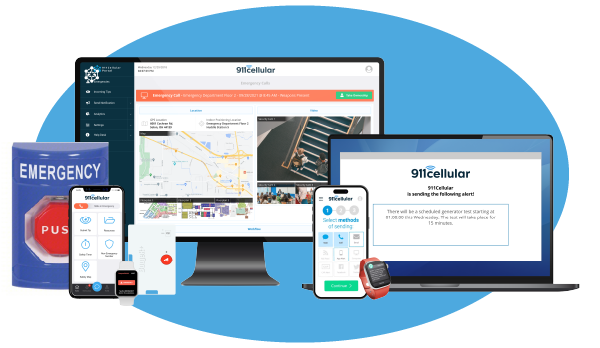Implementing Office Panic Buttons for Effective Security
Discover the importance of implementing panic buttons in office settings for enhanced staff security measures.
Benefits of Office Panic Buttons
Implementing panic buttons in office settings can provide several benefits for staff security. One of the main advantages is the ability to quickly and discreetly call for help in case of an emergency. Panic buttons can be installed at various locations throughout the office, allowing employees to easily access them when needed. This immediate response system can help to prevent or mitigate potential threats, such as workplace violence or unauthorized intruders.
Another benefit of office panic buttons is the peace of mind they offer to employees. Knowing that there is a reliable security system in place can help to alleviate anxiety and create a safer work environment. Panic buttons can also act as a deterrent, as potential attackers may think twice before targeting an office with such a security measure in place.
Additionally, panic buttons can improve response times in emergency situations. When a panic button is activated, it can instantly alert security personnel or law enforcement, enabling them to arrive at the scene faster and take necessary action. This swift response can potentially save lives and minimize the impact of an incident.
Overall, implementing panic buttons in the office can greatly enhance staff security by providing a quick and effective means of calling for help, offering peace of mind to employees, and improving emergency response times.
Types of Panic Buttons
There are several types of panic buttons available for office settings, each with its own unique features and functionalities. One common type is the wearable panic button, which is a portable device that can be carried by employees. These buttons are typically small and discreet, allowing individuals to easily trigger an alarm without drawing attention.
Another type of panic button is the fixed panic button, which is permanently installed in specific locations throughout the office. These buttons are typically mounted on walls or under desks, providing easy access for employees in case of an emergency. Fixed panic buttons can be connected to a security system or directly to law enforcement, depending on the level of integration.
Computer and keyboard panic buttons are cloud-based, software ‘buttons’ that can be easily installed on any desktop or laptop. These devices can be more cost-effective that traditional hardwired or fixed panic buttons, and they can be updated and tested at any time, which makes them a popular choice for enterprise rollouts.
Some panic buttons also come with additional features, such as silent alarms or duress codes. Silent alarms can discreetly alert security personnel without alarming the potential attacker, allowing for a more strategic response. Duress codes are secret codes that can be entered into a panic button system to trigger a specific response, such as locking doors or initiating a lockdown procedure.
The choice of panic button type depends on the specific needs and requirements of the office. Factors to consider include the layout of the workspace, the number of employees, and the level of integration with existing security systems.
Factors to Consider Before Office Implementation
Before implementing panic buttons in the office, there are several factors that need to be considered. First and foremost, it is important to conduct a thorough risk assessment to identify potential security threats and vulnerabilities. This assessment should include an evaluation of the office layout, existing security measures, and any previous security incidents.
Another factor to consider is the budget for implementing panic buttons. The cost of panic button systems can vary depending on the type of buttons, the number of buttons needed, and the level of integration with existing security systems. It is important to allocate sufficient funds to ensure the effectiveness and reliability of the panic button system.
Additionally, it is crucial to involve key stakeholders in the decision-making process. This includes management, security personnel, and employees. Their input can provide valuable insights and help ensure that the panic button system meets the needs and expectations of all parties involved. It is also important to establish clear protocols and procedures for using the panic buttons, including training employees on how to properly activate the buttons and what actions to take after activation.
Finally, it is important to regularly test and maintain the panic button system to ensure its functionality. This includes conducting routine inspections, replacing batteries if necessary, and updating the system as needed. Regular drills and exercises should also be conducted to familiarize employees with the panic button system and ensure a swift and effective response in case of an emergency.
By considering these factors before implementing panic buttons, offices can ensure that their security measures are effective, reliable, and tailored to their specific needs.
Training and Education for Staff
Implementing panic buttons in the office requires proper training and education for staff to ensure their effective use. It is important to conduct comprehensive training sessions to familiarize employees with the panic button system and its functionalities.
During these training sessions, employees should be taught how to properly activate the panic buttons in different emergency scenarios. They should also be educated on the appropriate actions to take after activating the panic buttons, such as seeking shelter, following evacuation procedures, or providing additional information to security personnel.
In addition to training sessions, regular refresher courses and drills should be conducted to reinforce knowledge and ensure that employees remain prepared and confident in using the panic button system. These drills can help to identify any areas for improvement and allow for adjustments to be made to the panic button system if necessary.
It is also important to provide ongoing education and communication regarding office security protocols and procedures. This can include regular updates on security measures, reminders on the importance of using panic buttons, and information on any changes or updates to the panic button system.
By investing in proper training and education for staff, offices can maximize the effectiveness of their panic button system and empower employees to take appropriate actions in emergency situations.
Integration with Existing Security Systems
Integrating panic buttons with existing security systems can enhance the overall effectiveness of office security measures. By connecting panic buttons to a central monitoring system, security personnel can receive immediate alerts when a panic button is activated, allowing for a swift response.
Integration can also enable additional functionalities, such as video surveillance or access control. Panic buttons can trigger cameras to start recording, providing valuable visual information for security personnel. They can also be used to lock or unlock doors, restrict access to certain areas, or activate alarms.
Before integrating panic buttons with existing security systems, it is important to assess the compatibility and scalability of the systems. This may involve consulting with security providers or IT professionals to ensure seamless integration and avoid any potential conflicts or technical issues.
Integration can also extend to external parties, such as law enforcement or emergency response teams. Panic buttons can be directly connected to these entities, enabling them to receive real-time alerts and coordinate their response accordingly.
By integrating panic buttons with existing security systems, offices can create a comprehensive and interconnected security infrastructure that enhances staff safety and enables a more effective response to emergencies.
To learn more about office panic buttons, visit 911cellular.com
Tags: Mobile safety app







